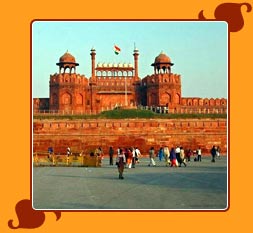It first occurred to the omniscient mind that he should
select on the banks of the aforesaid river some pleasant site, distinguished
by its genial climate, where he might found a splendid fort and delightful
edifices, agreeably to the promptings of his generous heart, through which
streams of water should be made to flow, and the terraces of which should
overlook the river.' Muhammad Tahir, Inayat Khan Shahjahan-nama, 1657-58.
Such worthy thoughts, according to the royal librarian, prompted the Mughal
Emperor Shah Jahan to found a fresh city at Delhi in the mid-seventeenth
century. He called it Shahjahanabad, meaning City of Shah Jahan. At its
centre stood the Red Fort, a vast walled complex of beautiful palaces and
meeting halls from which the Emperor ruled with unmatched public pomp and
ceremony.

Today,
the surviving Fort buildings stand silently amid the still bustling city,
now called Old Delhi. The Red Fort's success was instant. It represented the
pinnacle of Mughal palace-fort building, and symbolized political and
economic power. It was also perhaps the most extravagant and sophisticated
theatre ever built for daily performances of one of the world's most
dazzlingly grand courts. But its glory was short-lived; as the Mughal Empire
waned, so did the Fort. Later Emperors abused the fine buildings, raiders
snatched its treasures, marauders wrecked its buildings and finally the
British, blind to its qualities, pulled down the greater part. Even this
century, what remains has been largely ignored, unappreciated and uncared
for.
But, despite the ravages of time and human action, the
extraordinary achievement of the Red Fort in plan and fine architecture is
still visible today, although it is unjustly ignored. It is time to set the
record straight, to look again at the surviving buildings and to bring the
Fort alive through the personality of its creator, Shah Jahan, and his
Court. The Red Fort and its surrounding city constitute the only large-scale
Mughal city planned and built from scratch to survive as a living city.
Built in just over nine years, it burst into life in 1648 and, although the
palace buildings are peopled only by ghosts, the city it supported still
thrives today and the inhabitants of its tiny lanes are often descendants of
merchants and craftsmen who served Shah Jahan and his Court, still
practising the same trades in the same areas.
Here they live and
work, shop in the markets and celebrate their festivals in the streets. And
a few old families who a generation ago deserted the lanes for spacious,
air-conditioned comfort in the New Delhi suburbs keep the family haveli
(courtyard mansion) in Old Delhi and speak proudly of the city they come
from, even if they have never slept a night in it. The key to the Red Fort's
success was firstly that it was designed not merely for Court pleasure. It
may have contained glittering palaces, but it was also the power-base for
the whole Empire, for internal government and external foreign affairs. It
was built for defence, too, although this role would later prove its
Achilles' Heel. The Red Fort was also a complete community, a
city-within-a-city, with its own bazaars (the covered Chatta Chowk is a
token survivor), gardens and mansions for favoured courtiers.
Every
detail of layout and every building reflected Mughal greatness, using the
finest materials to realise the most mature Mughal designs. Secondly, the
supporting city was an essential part of the original plan. It had its own
protective walls; its great mosque, the Jama Masjid (Friday Mosque), stands
on the only hillock so all can see it; and its host of specialist bazaars,
which supplied the vast Court with everything it needed from silk slippers
to fresh Kabul melons. The city gained enough momentum to survive, albeit
less glamorously, when the Mughal Empire waned and, more importantly, when
the British built New Delhi and its competing shopping centre at nearby
Connaught Place. Thirdly, the whole of Shahjahanabad, both Red Fort and
city, was a thoroughly royal undertaking.
The city outside the
Emperor's palace-fort was an extension of it in design, patronage and
function. Indeed, Fort and city sustained one another, living in symbiosis.
The Jama Masjid encapsulates the idea, for it was planned as the mosque for
both the city and the royal Red Fort, which had no internal place of prayer.
The city's main market street, Chandni Chowk, was laid out by one princess;
additional markets, sarais (inns), Hammams (baths), mosques and gardens were
given by other members of the royal family; and grand havelis (mansions)
were built by favoured princes and courtiers. The havelis have mostly gone,
but those markets and places of worship are still focuses of Old Delhi.
Conversely, the public had access to the daily public meetings held in the
Diwan-i-Am (Public Audience Hall) in the Fort itself, a fundamental element
of Mughal rule. As a royal undertaking, the Emperor's personal interest and
vast finances were behind the project.
With a stable empire and a
huge income from taxes paid by his subjects, Shah Jahan could indulge his
obsession, building a new and magnificent capital whose centrepiece would
become a legend in his lifetime and whose magnificent planning and buildings
would survive, in part, to be admired by posterity. Shah Jahan seems to have
taken an active part in the design, direction and encouragement of the whole
project. He was involved in the general plan and in the detailed designs for
the marble palaces, the Chatta Chowk, the Jama Masjid and probably more. As
one recorder noted, perhaps with an overdose of loyalty: 'Occasionally His
Majesty supervised the work of goldsmiths, jewellers and sculptors.
Thereupon specialists commissioned to design new buildings would submit
their plans to His Majesty, who discussed them with expert persons .
Various monuments, which even the best-versed architect could not have
devised, were drawn up by His Majesty personally. His advice or his
objections were regarded as binding.' Forthly, the Red Fort and its city are
an inspired triumph of urban planning. Within the Fort, the core of the
design is T-shaped, the cross-bar consisting of a string of palaces facing
the Yamuna's cool river breezes on the east side of the Fort. To the west,
they face the main axis of the Fort and city: a procession of increasingly
less private and less royal buildings which leads to a giant gateway, out of
the seat of power and into the city's principal thoroughfare, Chandni Chowk.
Finally, each building in the Red Fort displays the hallmark of perfect
taste and elegance.
Built at the height of one of the most
cultured courts the world has known, this is Mughal palace architecture at
its most ambitious and sophisticated. Imagined in its original completeness,
it would have easily outshone its contemporary European rival, Louis xiv's
palace at Versailles, and it covered twice the area of the largest European
palace, the Escorial. Of the surviving structures, each one perfectly
fulfils its function. At the same time, each is visually satisfying, relates
happily to its neighbours and fits snugly into the overall plan. Lines are
simple, proportions human in scale, detailing restrained and both materials
and workmanship of the highest quality. Architectural historian Percy Brown
judged it in 1942 as 'the last and finest of those great citadels,
representative of the Moslem power in India, the culmination of the
experience in building such imperial retreats which had been developing for
several centuries.' Thus the Red Fort symbolizes the apex of Mughal cultural
refinement






